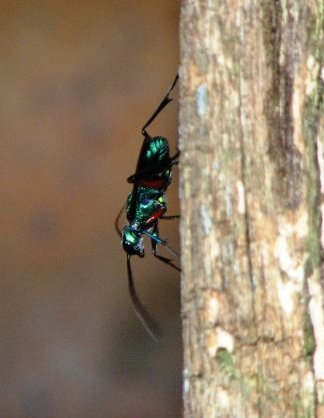Emerald Cockroach Wasp (Ampulex compressa) - Wiki Emerald cockroach wasp
From Wikipedia, the free encyclopedia
Order: Hymenoptera
Suborder: Apocrita
Superfamily: Apoidea
Family: Ampulicidae
[Photo] An emerald cockroach wasp (Ampulex spp.). Source: cropped from Flickr (www.flickr.com/photos/19335350@N00/538271844/). Date: June 09, 2007. Author: Tuan Cao (www.flickr.com/photos/19335350@N00/).
The emerald cockroach wasp or jewel wasp (Ampulex compressa) is a parasitoid solitary wasp of the family Ampulicidae. It is known for its unusual reproductive behavior, which involves disabling a live cockroach and using it as a host for its larva. It thus belongs to the entomophagous parasites.
Distribution
The wasp is common in the tropical regions of South Asia, Africa and the Pacific islands. The flying wasps are more abundant in the warm seasons of the year.
A. compressa was introduced to Hawaii by F. X. Williams in 1941 as a method of biocontrol. This has been unsuccessful because of the territorial tendencies of the wasp, and the small scale on which they hunt.
Appearance
The wasp has a blue-green body, with the thighs of the second and third pair of legs red. The female is about 22 mm long; the male is smaller and lacks a sting.
Reproductive behavior and life cycle
A number of venomous animals paralyze prey as live food for their larvae, but unlike them, Ampulex compressa initially leaves the roach mobile, but modifies its behaviour in a unique way. Several other species of the genus Ampulex show a similar behavior of preying on cockroaches.
As early as the 1940s it was published that female wasps of this species sting a roach (specificially a Periplaneta americana, Periplaneta australasiae or Nauphoeta rhombifolia) twice, delivering venom. A recent study using radioactive labeling proved that the wasp stings precisely into specific ganglia of the roach. She delivers an initial sting to a thoracic ganglion and injects venom to mildly and reversibly paralyze the front legs of the insect. This facilitates the second venomous sting at a carefully chosen spot in the roach's head ganglia (brain), in the section that controls the escape reflex. As a result of this sting, the roach will first groom extensively, and then become sluggish and fail to show normal escape responses. In 2007 it was reported that the venom of the wasp blocks receptors for the neurotransmitter octopamine .
The wasp proceeds to chew off half of each of the roaches antennae. The wasp, which is too small to carry the roach, then leads the victim to the wasp's burrow, by pulling one of the roach's antennae in a manner similar to a leash. Once they reach the burrow, the wasp lays a white egg, about 2 mm long, on the roach's abdomen and proceeds to fill in the burrow entrance with pebbles, more to keep other predators out than to keep the roach in.
With its escape reflex disabled, the stung roach will simply rest in the burrow as the wasp's egg hatches after about three days. The hatched larva lives and feeds for 4-5 days on the roach, then chews its way into its abdomen and proceeds to live as an endoparasitoid. Over a period of eight days, the wasp larva consumes the roach's internal organs in an order which guarantees that the roach will stay alive, at least until the larva enters the pupal stage and forms a cocoon inside the roach's body. Eventually the fully-grown wasp emerges from the roach's body to begin its adult life. Development is faster in the warm season.
Adults live for several months. Mating takes about one minute, and only one mating is necessary for a female wasp to successfully parasitize several dozen roaches.
Pop culture allusions
The creature is often compared to (and sometimes given as a source of inspiration for) many parasites and parasitoids in science fiction. Some examples are as follows.
Headcrab - From the video computer game series Half-Life
The Flood - From the video game series Halo
Goa'uld - From the TV show and movie Stargate SG-1 and its spinoffs
Yeerk - From the Animorphs franchise
Facehugger - From the Alien series of films
http://en.wikipedia.org/wiki/Emerald_cockroach_wasp
| The text in this page is based on the copyrighted Wikipedia article shown in above URL. It is used under the GNU Free Documentation License. You may redistribute it, verbatim or modified, providing that you comply with the terms of the GFDL. |
